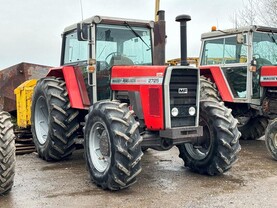Fendt is regarded by many as the top of the pile in the tractor world with a price tag to go with it. However, the Toplink.ie section in the Irish Farmers Journal prove they hold their secondhand value, with 10,000+ hour examples commanding big money.
Approaching the cab of this tractor, the Irish Farmers Journal parks all previous Fendt experiences to one side. This tractor comes in three specification levels – Power, Profi and Profi Plus. We tested the latter version, with the highest specification level of all three. Climbing in is easy thanks to a low door handle and wide steps.
The cab is bright, spacious, packed with technology and there is glass everywhere. Even the one-piece windscreen stretches up beyond the roof line and curves backwards. The Grammer air seat is comfortable, with numerous adjustment functions and the Vario joystick on the right-hand console comes naturally to meet my right hand. This lever can control lots of functions. Forward speed, direction change, automatic headland sequence, hydraulic valves, cruise control and numerous other aspects of the tractor’s operation are at the press of an easy-to-reach button.
When driving the tractor, pushing the lever forward increases speed and pulling it back decreases it. Alternatively, it can be driven using the floor accelerator when the TMS (Tractor Management System) is engaged. The driver can speed up or slow to a stop without using the Vario joystick.

Rate of acceleration is easily adjusted with a small toggle switch on the rear of the lever. To the right of this, a stubby cross-gate lever can be used for a number of hydraulic functions, its functionality similar to that of a dedicated loader control lever. For this test, we used it to control all loader functions, but this can be changed pretty quickly. Beyond this, the linkage controls are grouped together in a round dial that fits into the palm of your hand. A yellow button underneath my index finger engages and disengages the PTO while speed selection (540, 540E and 1,000 RPM) is selected on the colour-coded side console.
Behind this console is the 7in Vario terminal, which is a control screen for all aspects of the tractor. Numerous tractor settings, hydraulic flow and timing, headland sequence, transmission adjustment, auto-steer where fitted, and information recording are all displayed and manipulated here. The touchscreen can also be used as a control terminal for an implement at the rear of the tractor if it is ISOBUS compatible. All this is top spec, with more technology and functionality than most will ever need for even the most technologically demanding job.
On the immediate right side of the driver is a control panel with colour-coded buttons to make quick adjustment on the go. It’s a very straightforward affair with orange for transmission, blue for linkage, green for 4WD and differential lock and yellow for PTO speed selection. There is also a white button for auto steer engagement.
Let there be light
This tractor is not short of work lights, with eight on the front plus the two headlamps and six on the rear. Selecting them couldn’t be simpler from the blister pad. A diagram denotes which part of the tractor they are mounted on so, depending on the job, you can have all of them illuminated or just a few. In our lighting test, there was a very even spread of light in the 5m arc from left to right in front of the tractor. If we had any observation to make, when the loader was raised it reflected light back into the driver’s line of sight, making seeing beyond the loader difficult.
Rearwards, the work lights worked very well and we had no quibble with their illumination. Air-conditioning and fan speed are also controlled from the same panel, as is rear wiper and window demister.
Behind almost every button on this side console is a small LED which denotes when a particular function is engaged. This is useful, but such is their small size, they could be easily overlooked when left on.
For those who still like fresh air flowing through the cab without the air-conditioning running, there is a sizeable roof hatch which also serves as an emergency escape hatch.
A factory-installed Bluetooth kit with adjustable microphone is a really nice feature. Again, Fendt has listened to owners and acted on what drivers want. Also located in the roof panel are numerous power outlets for control boxes.
Access to the engine bay is through a locked engine bonnet – a plus for the security-conscious owners and complies with recent tractor mother regulations.
Once opened, there is enough space between the various coolers to easily blow them out with an air hose. A rubber flap on either side can be quickly removed, giving unrestricted access to the space in front of the radiator.
A transparent expansion tank can be checked from ground level. One criticism we did have with the engine bay was getting to the air-filter. We had to stand above the front linkage on the flat area in front of the radiator and reach back over the engine to undo four steel clips.
We also tried from the ground but the loader and mudguard obstructed access, making it a frustrating service job that will more than likely not be done as often as it should. Aside from this minor issue, pulling the orange-tipped engine oil dipstick is easily done, as is filling it with engine oil.

Heavy lifter
Moving around to the rear of the tractor, colour coding of the hydraulic couplers is clear. One coupler is used to raise and lower the Bill Bennett pickup hitch independent of the linkage arms with three free for other functions. As it is lowered, it moves out from the tractor, which makes hitching up a lot easier. The absence of hitch lift rods greatly increases hook visibility.
Pneumatic cab suspension in conjunction with air seat and front suspension mean this is a comfortable tractor to drive. Cab air filter is accessible from the ground at the rear of the tractor below the rear window.
Air brakes are standard on Fendt tractors with single line hydraulic also available. The ISOBUS coupler is within easy reach. Very chunky stabiliser bars will stop the most substantial of implement from swinging side to side and can easily be locked into position. Rear lift capacity of the 312 Profi is 5,200kg.
At the other end of the tractor is the factory-fitted Compact 4X75 Cargo front loader. Loader geometry is very good, with visibility to the attachment points at the front very clear. This is a loader that has been designed specifically for this tractor range and fits well.
Cycle times are fast thanks to an 84l/min or 110 l/min hydraulic pump which for a tractor of this size is more than enough.
Loader lift capacity is just over 2,294kg. A mechanical locking mechanism locks the pins into the bottom of the attachment once crowned backwards. Attaching and detaching the front loader was very straightforward and clicked easily into place.
The loader multi-coupler took care of all hydraulic hoses and electrical cables to the loader which was easy to undo.
Drivetime
After the brief instruction from a Fendt representative, we set off. Pushing the lever forward and pulling backwards adjusted speed.
Activation of the lever requires depressing an activation pad on the rear which quickly becomes second nature. We used this tractor extensively for both loader work and transport work.
In transport mode it was a breeze to drive using the Vario joystick. This was the only tractor in the test series we used with IVT (Infinitely Variable Transmission).
When TMS was activated, we just sat back and used the foot throttle to control forward speed. This freed up our right hand to change direction.
Around the yard, the tractor worked very well. Copious amounts of glass really help and the large mudguards kept the windscreen clean. The wiper works in a broad arc but would have been the cherry on the cake if it worked in a wide circle keeping sight of the wheels and loader clear. A small complaint.
The Fendt 312 and 4X75 loader work really well together. This tractor has more technology, specification and features for even the most demanding customer. The cab is very comfortable and a nice place to work. The engine is powerful and managed to squeeze out 127.1 PTO hp at 1,000 RPM. Torque reserve was measured as 19% across a broad torque curve with a maximum torque of 1068 Nm of torque – all told, impressive results in an impressive package. The stumbling block will be this tractor’s price, which will put off a lot of even the most tech-hungry customers. For the model we tested, including front loader, the price of €158,241 (£138,953) plus VAT might be a bridge to far.







 This is a subscriber-only article
This is a subscriber-only article



































SHARING OPTIONS: